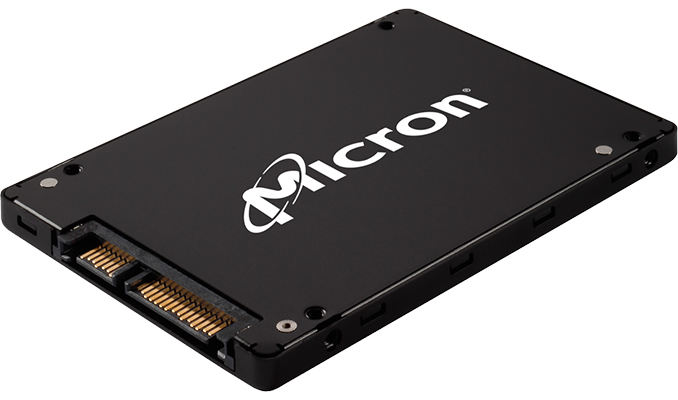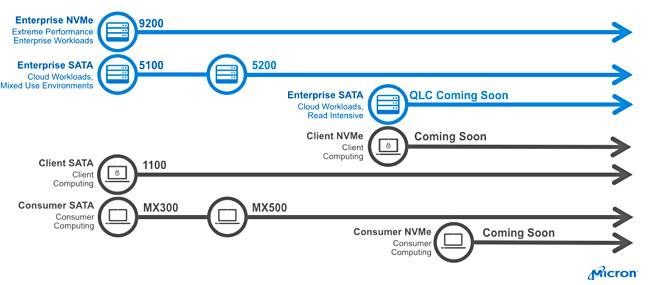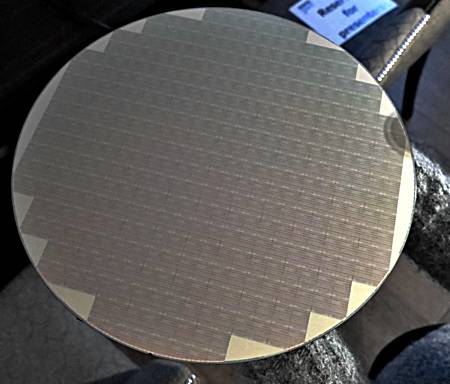Micron Readies 3D QLC NAND-Based Datacenter SSDs for Nearline Storage
by Anton Shilov on February 12, 2018 3:00 PM EST
Micron has revealed plans to release datacenter-class SSDs based on 3D QLC NAND memory in an effort to compete in the nearline storage market. Briefly announced at a conference last week, the company is taking aim at applications that currently use 7200 RPM HDDs, the use of which is increasingly common in nearline storage. The manufacturer did not reveal any additional details about the upcoming drive, but demonstrated a wafer with QLC 3D NAND dies.
Micron disclosed its plans concerning own-brand SSDs in 2018 at the A3 Technology Live conference in London last week. Among other things, the company intends to introduce a QLC-based SSD with a SATA interface for cloud datacenters this year. The drive will be positioned below the existing 5200-series SSDs and will be aimed primarily at read intensive applications (or the so-called WORM — write once, read many workloads). The QLC-based SSD will have a feature set aimed at hyperscale datacenters and will compete for the place currently occupied by high-capacity 7200 RPM HDDs, reports The Register.
The manufacturer did not disclose capacity of the upcoming QLC-based drives and did not reveal whether they will feature in-house developed controllers with enhanced ECC capabilities (developed using IP and engineers the company got when it acquired Tidal Systems several years ago), or third-party enterprise-grade controllers. The company demonstrated a wafer carrying 64 GB (i.e., 512 Gb) 3D QLC NAND chips, indicating that it has the new flash memory at hand already.
QLC flash memory stores four bits per cell, thus offering a 33% higher bit density and lower per-bit cost compared to TLC flash commonly used for high-capacity SSDs today. 3D QLC NAND has been formally announced by Toshiba and Western Digital so far, but there are no doubts that all producers of NAND are working on QLC chips too. Increasing the bit density of NAND flash usually comes at the cost of endurance, but Toshiba last year said that it had managed to increase endurance of its 3D QLC NAND flash to 1000 program/erase cycles by using a stronger ECC mechanism, which is comparable to endurance of 3D TLC NAND.
QLC’s higher bit densities as well as lower per-bit costs are expected to reduce per-GB prices of high-capacity SSDs further and enable them to compete against existing leading-edge HDDs, such HGST’s Ultrastar with 12 or 14 TB capacity. Two obvious advantages that high-capacity QLC-based SSDs will have when compared to hard drives are lower latencies and higher storage densities. Meanwhile, per-GB costs of HDDs will remain lower when compared to NAND flash for years to come — this is what producers of both HDDs and flash memory agree on. So I'd expect to see that these upcoming 3D QLC NAND-based SSDs will sit between high-capacity HDDs and high-performance SSDs, occupying a tier of their own in hyperscale datacenters.
Related Reading:
- Western Digital Announces Four Bit Per Cell 64-Layer 3D NAND Flash
- Toshiba's 768Gb 3D QLC NAND Flash Memory: Matching TLC at 1000 P/E Cycles?
- Micron 2017 Roadmap Detailed: 64-layer 3D NAND, GDDR6 Getting Closer, & CEO Retiring
- Micron 3D NAND Update: 2D and 3D NAND Bit Crossover, Gen 2 Hits Production












29 Comments
View All Comments
CheapSushi - Tuesday, February 13, 2018 - link
Heck no, I'm excited and looking forward to QLC SATA/AHCI for bulk storage. I'm waiting on drives to come out to start my homelab builds. Hell, I want them to be DRAMless also, to make BoM cheaper. We've got plenty of NVMe/PCIe drives now for cache & performance including improved V-NAND TLC (which lasts MUCH longer than you'd probably give credit to, upcoming Z-NAND (which acts like SLC) and also Optane (which I think is GREAT; looking forward to x4 laned M.2s). I see zero issue with QLC in laptops and other products. I'm guessing you're the type of person to only use or want a SINGLE drive for an entire system? Ehhh. I guess I see issue there then.CheapSushi - Tuesday, February 13, 2018 - link
Forgot to add that a QLC NAND drive will still be better at random read & write, and bursts, than any HDD, 3.5" or 2.5" that budget products would have. And that's a performance region where the vast majority of said systems are working in. High queue depth, sequential, sustained operations are rarer.BurntMyBacon - Thursday, February 15, 2018 - link
@CheapSushi: "Forgot to add that a QLC NAND drive will still be better at random read & write, and bursts, than any HDD, 3.5" or 2.5" that budget products would have. And that's a performance region where the vast majority of said systems are working in."I believe these will be targeted at what HDDs are currently targeted at. What you state is true if these are used as a primary storage device on a system that would otherwise have a HDD filling that role. However, in a secondary bulk storage role where there is a much lower frequency of access and accesses are much more sequential in nature, the superior random access characteristics may go unnoticed.
danielfranklin - Tuesday, February 13, 2018 - link
My concern is certainly not for me or you, but for the millions of consumers out there who do only run a single disk system.I fully agree in a a perfect world more levels of nand for people in the know is better, ive just seen how the market deals with this before and thats where my concern is.
theuglyman0war - Tuesday, February 13, 2018 - link
Not read anything on what impact the new pci-e 4.0 and upcoming 2020 pci-e 5.0 versions will have on storage performance? New sata specs to leverage as much? As well as Product lines in the works that take advantage of the new versions?( been stuck at pci-e 2.0 buying into x58...
Incremental performance iterations since then has soured my enthusiasm for upgrading past my i7-980x for which remains quite adequate for my workstation needs .vrt pulling in zbrush...
But since Coffee-lake introduced 6 cores providing an obviously sexy hedt alternative that matches my current core count... The upgrade enthusiasm is back )
However...
I am in no hurry to buy into a defunkt PCI-E version again and suffer storage compromises ( like I have under marvell's oppressive sata 3 controller on the x58 for the past 8 years! On the same dam year PCI-E 3.0 released! Talk about bad timing )
Personally hoping the rumored 8-core Cannon-lake releases in April ( further blurring hedt/xeon skus ) with PCI-E 4.0 implemented in motherboard lines hopefully in addition to a slew of announcements from all the storage players touting new tech/product lines leveraging the bandwidth/thruput?
Where PCI-E 5.0 scheduled in a year and a half
theuglyman0war - Tuesday, February 13, 2018 - link
Sure seems making a major investment risky? After 8 years of 3.0...I would hate to be stuck waiting out another 8 years stuck at 4.0 because I jumped the gun in this clausterphobic release season right before 5.0 which again supposedly doubles bandwidth?
( would be like being stuck at 3.0 while tje rest of the world got to realize a comparably NVLINK advantage )
Ghetto resentment!
Trying to not get to excited for anything and just make tmp builds till 5.0...
Just seems to important of a timing concern to make major investments without consideration of 5.0 128GBps lanes compared to today's 32GBps or even stuck at 4.0's 64GBps bandwidth waxing for that 2x leap.
frenchy_2001 - Wednesday, February 14, 2018 - link
PCIe 4.0 is not even implemented yet and you're already talking about 5.0? 0_oI think you are putting too much faith in the industry if you think it will move that fast.
I understand you do not want to "miss out" on the latest tech, but I feel you are misguided.
If you look back at PCIe 2.0 to 3.0, very few applications actually use it.
Go check benchmarks of recent graphic cards tested on Sandy Bridge and latest processors to see that your loss is more theoretical than real.
Storage has moved from SATA3 to PCIe, but even then, the real usage difference between the best SATA3 SSD (which you can still use on your platform) and a more recent PCIe 3.0 SSD is negligible (unless you're running a storage heavy server load).
Conclusion: Upgrade when you need to, to an equipment you'll be happy with, not when the technology changes (unless you know a new product is literally right around the corner in a matter of weeks). The march of technology never stops and there is *always* something better coming (intel and nvidia have new products every year after all).
FunBunny2 - Tuesday, February 13, 2018 - link
whether the P/E value is credible will be determined by the node used. current TLC on 3D is said to be on 40-50 nm, thus gaining charge count/cell. one might hope that QLC is at least on these nodes.frenchy_2001 - Wednesday, February 14, 2018 - link
There was no plan to shrink the node for 3D NAND last I heard.See 3D NAND as a tower. They need a "base" of a certain size, otherwise, they risk it toppling over.
So far, they just increase the number of floors to increase density (from 32 layers to 64 then 96).